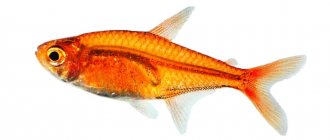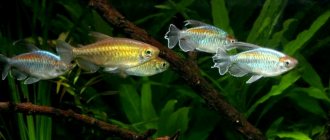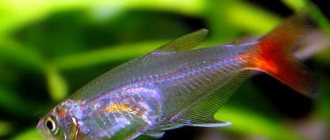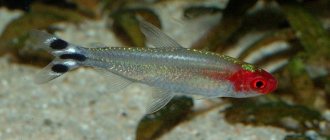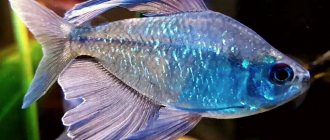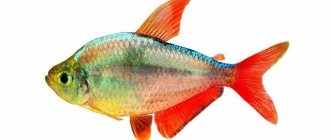Habitat
This species was discovered in the Peruvian Amazon in 1937 and is widespread in the tropical zone of South America. In the wild, they prefer shallow areas of the river with a slow flow and dense vegetation, and flooded forest areas. They can often be found in large groups numbering hundreds and sometimes thousands of individuals. The fish have been successfully acclimatized and are being reared en masse for commercial purposes. Currently, several selective forms have been bred that are not found in the wild, for example the albino Lemon Tetra. Requirements and conditions:
- Aquarium volume – from 60 l
- Temperature – 22 – 28 ° C
- pH value – 5.5–8.0
- Water hardness - from very soft to hard (3-25 DGH
- Substrate type - sand
- Lighting - dim
- Brackish water - no
- Water movement is weak
Fish parameters:
- Size - up to 5 cm
- Food - any
- Life expectancy - from 4 to 8 years
Lemon tetra - Hyphessobrycon pulchripinnis
The lemon tetra is native to the Rio Tapajos River basin in Brazil, where it prefers shallow, gently flowing areas with dense vegetation. In its natural environment, the lemon tetra lives in large flocks numbering hundreds of individuals. Appearance and gender differences
The lemon tetra has an elongated, flat, laterally compressed body of a rich lemon-yellow hue, sometimes with a beautiful silvery tint. This fish is distinguished by large expressive eyes, the upper part of which has a bright red edging. The caudal, pelvic and pectoral fins are almost transparent, with a slightly noticeable yellowish tint. The dorsal fin is golden in color and has black rays. The anterior part of the anal fin is bright yellow with black edging along its entire length. It is by this edging that one can distinguish a male from a female. In the male, a wide black border runs along the entire lower edge of the anal fin; in the female lemon tetra, this border is narrower and, as a rule, half as long. Also, sexually mature females are larger than males and are not so brightly colored.
The maximum size that a lemon tetra can reach in a home aquarium is 4–5 cm, but, as a rule, its size does not exceed 3.5 cm. Life expectancy under good maintenance conditions is about 3–5 years. Conditions of detention
Lemon tetra is a collective fish, and in the natural environment they form quite large schools, so it is preferable to keep them in a group of 5 or more individuals. An aquarium for such a company will require a volume of 80 liters or more. It is advisable that it be extended in length - this will provide the nimble tetras with a comfortable space for swimming. When decorating an aquarium, preference should be given to living plants, with the help of which you can create natural islands with dense vegetation that will provide a natural shelter for fish. It is best to plant plants around the perimeter, as there should be enough free space for swimming in the aquarium. Dark soil is preferable - this intensifies the color of the lemon tetra.
The lemon tetra is a fairly hardy fish, but due to its relatively small size it is sensitive to water purity. Therefore, it is necessary to take care of effective filtration and aeration in the aquarium, and water changes should be carried out at least once a week (25% for fresh water).
Lemon tetra adapts well to different conditions, but feels best under water parameters: temperature 24 – 27°C, pH 6.0 – 7.0, dGH 2 – 12°.
Aquarium mates
A small flock of these peace-loving fish will decorate any species aquarium inhabited by fish of similar size and temperament. Any other species of characin fish, all species of viviparous fish, peaceful species of barbs, small bottom fish, etc. will be excellent neighbors. They should not be kept together with large or aggressive species, as tetras simply will not be able to fight back. Feeding
There are no problems with feeding the lemon tetra - the fish accepts with equal pleasure any food offered to it (of a suitable size). Frozen brine shrimp, daphnia, small bloodworms, coretra, tubifex or cyclops, as well as small dry flakes or granules are perfect for feeding. It is advisable to include herbal supplements in the diet. Try to alternate different types of food, as this has a positive effect not only on the general well-being of the fish, but also on their appearance. The more varied and filling the diet of the lemon tetra, the brighter and more saturated its color. Breeding
To breed lemon tetras, you need a separate spawning aquarium, with a volume of 10 - 20 liters per pair of fish. In order to protect future eggs from being eaten by producers, a separator net and small-leaved plants should be located at the bottom of the aquarium, which will serve as a substrate for the eggs. The maximum water level in the spawning tank is 15 cm, water parameters: temperature 25 – 26°C, dGH 2 – 5°, pH 6.6 – 6.8. For spawning, they choose a pair of fish that have shown interest in each other while still in the aquarium. The productivity of a female directly depends on her age and usually ranges from 100 to 300 eggs.
As soon as the spawners have completed spawning, they must be removed from the aquarium, and up to 50% of the water in the spawning tank should be replaced with fresh water (of the same composition and temperature). With a small volume of spawning tank and a significant amount of milt released by the male, the water often becomes cloudy, resulting in oxygen deficiency - this leads to disruption of the normal development of eggs. The spawning ground is shaded and the water is gently blown with air. After a day, very small transparent larvae hatch from the eggs, and already on the fifth day the fry begin to swim and eat food. By the end of the first month of life, the juveniles are completely colored, and at 8–9 months the fish are already able to reproduce.
Maintenance and care
The main condition for successful maintenance is maintaining high water quality, which can be achieved by using an effective filtration system and updating part of the water (25-50%) every two weeks. The lighting system should be set to low light, simulating shady forest streams. Other necessary equipment: heater, aeration system. In design, it is recommended to use dense thickets of plants along the side and back walls of the aquarium to leave the central area free for swimming. Artificial elements (castles, ships, etc.), as well as natural stained wood, roots, and driftwood, are suitable as shelters. The soil is sandy. A few dry leaves (pre-soaked) will give the water a light brown color, which is typical of their natural habitat. Leaves should be replaced every two weeks, which can be combined with cleaning the aquarium.
Compatibility
The lemon tetra is an extremely peaceful fish. Other small and non-aggressive inhabitants will become good neighbors for her:
- other characins: neons, ornathus, thornets, minors, rhodostomus, etc.;
- small fish: Schubert and cherry barbs, zebrafish, rasboras, etc.;
- peaceful cichlids such as apistograms or angelfish;
- non-aggressive labyrinths, such as lalius;
- various catfish: ancistrus, platidora, speckled, etc.;
- but with veil species you need to replant with caution, since long fins can be torn off.
Breeding/reproduction
It is successfully bred in home aquariums; the best effect is achieved when there are 2 males per female. For spawning, a separate tank with a volume of 3–40 liters is required; the quality and composition of the water must match the main aquarium. The set of equipment is as follows: airlift filter, aerator, heater and lighting system. The design must include floating plants; it is on their leaves that fish lay their eggs. The stimulus for spawning is enhanced nutrition with the inclusion of meat products in the daily diet. When it is noticeable that the female’s abdomen has become rounded and large, it means it’s time to lay eggs. She and her partners are placed in a separate tank, where eggs will be laid after some time. After which the parents are removed to a common aquarium. The fry appear within a few days; feed them with microfeed and brine shrimp.
Nutrition:
The food should include a variety of commercially available foods, both live and dry. It should be borne in mind that fish are very insatiable and can be easily overfed, so food must be strictly dosed. In addition, overfeeding negatively affects the health of females; due to frequent overeating, they become infertile over time.
Possible diseases
Representatives of this aquarium species prefer to live in the lower or middle layers of water. If the aquarist notices that the fish begins to rise to the surface more often and at the same time its breathing changes and becomes rapid, this is a sign that there is insufficient oxygen level in the water for the fish. If this happens, it is necessary to replace the water at least ¼ of its total volume. Additionally, you need to turn on aeration and connect the filter more often.
Lemon tetras, especially females, have a tendency to obesity, so it is strictly forbidden to overfeed them, and there should be no leftover food in the aquarium after feeding, they must be removed after 5-10 minutes.
To prevent obesity, you can give your pets a fasting day every 2 weeks.
In addition, lemon tetras are also susceptible to fungal diseases that arise due to poor water quality, inappropriate parameters and severe pollution. Due to contamination, simple parasitic organisms can grow on fish scales. If you create all the necessary conditions for the fish, the lemon tetra will have good health and fairly high physical endurance.
Feeding
You will have no problem feeding lemon tetras. They are omnivores and quickly adapt to new food. The basis of their diet should be high-quality dry food, such as flakes or small granules.
You can also improve coloration by diversifying your fish's diet. In addition to dry food, provide live, frozen or freeze-dried food from time to time. Lemon tetras love daphnia, finely chopped shrimp, bloodworms and brine shrimp.
Feed them small meals once a day. There should be as much food as they can eat in 2-3 minutes.
Possible diseases
Lemon tetras can suffer from all common freshwater diseases. The most common illnesses to watch for include intestinal infections, bacterial infections, and parasitic infections. All of these conditions are contagious and can quickly spread throughout your aquarium if you are not careful.
Fortunately, most diseases can be treated by quarantining the purchase of new fish and over-the-counter medications, sold both at regular pharmacies and in pet stores. Moreover, most diseases can be avoided with proper care.
Monitor the condition of the water and check the parameters regularly. You also need to make sure your filter is working efficiently. To reduce ammonia and nitrate levels, change 25% of your water to fresh water every week.
Poor health of a fish can be determined by its appearance. If they are sick, the intense coloring will begin to fade. The color changes become even more noticeable when you pay attention to the brightness of their red eyes.
Characteristics of appearance
The name of the species perfectly reflects its appearance. The main color is yellow, the scales are silvery. The body shape is slightly flattened laterally. A distinctive feature of tetras is their translucent body. eyes deserve special attention - when light is reflected in them, they sparkle with a bright ruby color. The body length of an adult does not exceed 5 cm. The life cycle lasts 4-8 years.
The color pigment on the fins is weakly expressed, only when light hits them can you see that they are pale yellow, almost transparent. The dorsal fin has black rays. The female differs from the male in that her anal fin at the bottom is bordered by a black stripe, which is exactly 2 times shorter than that of males.
Another distinctive feature of females is that they have a wider body and are several shades lighter in color. When spawning begins, dark grains of eggs can be distinguished through the translucent body of the females in the swim bladder. It is thanks to this trait that during the spawning period it is possible to select the most promising individuals for reproduction.
